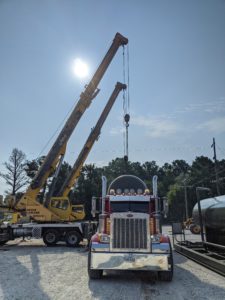Two years ago the story on trucking revolved around little work, low diesel prices, and layoffs or reductions in hours/trips.
This year the situation has flipped 180 degrees. There’s almost too much work, diesel prices are sky high, and it’s hard to hire enough workers. Plus, trucks, trailers, and repair parts are in short supply.
Changing economics along with international events are the top driving forces in the change, said Michael Clements, Jr., president of PDQ America, a freight brokerage firm headquartered in White Oak, Texas. In 2022 they’re mainly hauling completed equipment, raw materials, concrete, and infrastructure pieces. Also, hotshot work is booming. Referring to the Russia/Ukraine situation he noted, “With that coming right in after COVID, you want to talk about a one-two-punch with those two things as well as a super volatile economy, inflation here in the United States—I think all these things created kind of a weird dynamic.”
Inflation has been among the bigger challenges for everyone, including the trucking industry. Freight prices have been on the rise over the last two years. “In late 2020 and all through 2021 rates went up because of capacity and also what it cost to get equipment,” he said. Capacity rose faster than companies could rehire workers and get trucks back on the road.
Purchase prices for trucks and trailers have also shot up since late 2020. As shipping opportunities in the oilfield and elsewhere have returned, Clements has seen a large number of people buying trucks and trailers and moving into the arena as independent owner-operators of small trucking firms. This has created a shortage of that kind of equipment, which has driven the prices up dramatically.
“You’ve had people leave big trucking companies and say, ‘Hey, I’m going to go out on my own, think I can do this’ and they go out and buy a truck and a trailer.” Starting from a situation of a capacity shortage, this flurry of movement eased that situation. Unfortunately, the new operators quickly ran into the doubling of diesel prices.
One positive about the higher diesel prices, Clements said, is that it makes customers more understanding about rising freight costs. “People are not being too picky about the price right now,” as long as they can get their equipment delivered.
Clements has observed a difference in activity between the Permian and the East-Texas/northwest Louisiana Haynesville formation. Even though Permian rig counts are up by around 200 since the lows of 2020, he hears companies are still hesitant to plunge back in full tilt there. “But over here in East Texas, you have the Haynesville Shale, and we’re rocking and rolling.” His area contacts say activity in the Haynesville would be even greater if companies could find enough workers.
PDQ is affected by the labor supply as well. “We’ve been trying to hire welders and fitters for the last four or five months. Truck drivers are [also] hard to find.” He added, “The supply chain of people is also an issue right now in the oil field.”
On a national basis, the American Trucking Association said that the trucking industry as a whole ended the year 2021 short about 80,000 drivers. By 2030, should current trends continue, the industry could be short as many as 160,000 drivers.
In addition to trucking, PDQ also manufactures vessels—and that’s where the parts supply chain issues hurt the most. “One of the biggest holdups we’ve had is parts. You’ll have a small valve or you’ll have a small piece of a small vessel that’s holding up the entire production of that vessel.” He noted that, if there’s an opportunity to get more than one of a critical part, they’ll buy enough to get ahead.
Fuel Challenges
Those fuel price signs flashing per-gallon numbers starting with fours and fives (and in some regions, sixes) are some of the highest prices on record—with no sign of abatement any time soon. Much of this is the result of decreases in E&P development during and after COVID, the shutdown of unprofitable refineries that are not likely to be reopened—and, of course, the Russian action in Ukraine.
As Clements referenced supply chain issues for parts in his company’s manufacturing side, high gasoline and diesel prices are also part of the supply chain issue. The U. S. Energy Information Administration (EIA) reported in May that average U. S. prices for diesel were up $1.573 per gallon over 2021 prices. The greatest increases have been in New England ($1.759), Central Atlantic ($1.741) and the West Coast ($1.795). At just $1.185 per gallon, the Rocky Mountain region’s year-over-year price increase has been the nation’s smallest.
Some experts have predicted shortages in the U. S. Northeast this summer during the driving season.
While no shortages are predicted for Texas and the Southwest, likely due to the proximity of the huge refining industry along the Gulf Coast, high fuel prices are causing trucking companies to raise prices, adding to the total cost of the goods that can be delivered.
But there is a hidden part of the equation that’s apparent only to truckers and to owners of diesel powered pickups and RVs. Since 2010, the EPA has required trucks to add diesel exhaust fluid (DEF) to their fuel in order to reduce emissions of nitrous oxide (NOx) and particulate matter. DEF is stored in trucks in a separate tank, added into the fuel flow as it enters the engine. Its tank has a blue cap, so DEF is commonly known as AdBlue.
Trucks are equipped with sensors for the DEF tank just like for the fuel tank. The difference is that when the truck’s sensor detects an emptying DEF container, it slows the truck down to as low as 5 MPH. So basically, the truck is not allowed to run without it, to meet emissions standards.
So what’s the problem? DEF is made up of two components: urea (32.5 percent) and deionized water (67.5 percent). The problem is specifically the urea, which is made largely from natural gas.
Russia and China have been the world’s top exporters of urea, and Europe has been a top exporter of DEF to the United States. China has reduced exports to maintain its domestic supply and sanctions on Russia have slashed its exports. Europe depends on Russian gas, and is experiencing its own supply chain issues.
Also, urea is a key ingredient in many fertilizers. Its worldwide shortage has already caused fertilizer costs to skyrocket, potentially affecting food production around the world.
Clements says he’s aware of the issue, but that “it’s not something we have heard major concerns about. It’s a conversation that has been going on since beginning of year and it does seem to be gaining more steam.”
What’s Up the Road for Trucking?
 The word “bloodbath” is floating around the trucking industry now, Clements noted. That’s because the owner/operators who were new to the sector in the last year or so paid very high prices for their equipment—and are now being hit with higher diesel prices. This may make it hard for them to net enough per haul to make payments on trucks and trailers, especially if predictions of a recession come true. That would have the effect of reducing loads and squeezing freight rates, even if diesel prices stay high.
The word “bloodbath” is floating around the trucking industry now, Clements noted. That’s because the owner/operators who were new to the sector in the last year or so paid very high prices for their equipment—and are now being hit with higher diesel prices. This may make it hard for them to net enough per haul to make payments on trucks and trailers, especially if predictions of a recession come true. That would have the effect of reducing loads and squeezing freight rates, even if diesel prices stay high.
On the other hand, “Larger companies are shielded from that, they have long-term contracts, they’re able to work their rates in different ways. But owner/operators, they may have only one or two direct shippers, and then they work with a lot of brokers.”
Turning on a Dime
As they saying goes, the only thing consistent in (name the industry) is change. That is overwhelmingly true for oil and gas, especially since 2020. Finding supplies of parts, equipment, fuel, and even drivers is becoming a full-time concern. But the 2022 crisis has done one thing—it has converted many of the “keep it in the ground” proponents to “drill baby, drill,” at least for now. Realizing the importance of oil and gas to the people of the world—now and in the future—is possibly a first step toward energy reality.
By Paul Wiseman












